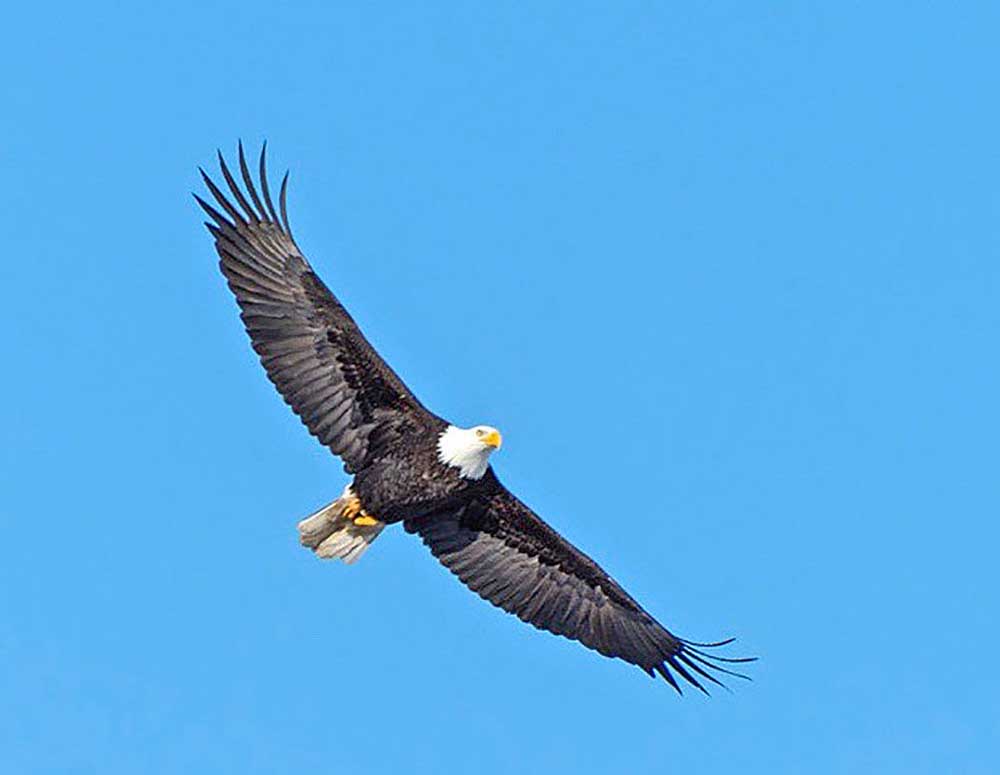Coast Chronicles: Flights of Fancy
Published 3:51 pm Sunday, February 24, 2019

- The wingspan of a mature bald eagle can be seven feet or more.
Sometimes I’m in sheer awe of our English language. I know it’s probably not anything folks stop and ponder often since language is so invisibly workmanlike. We think in English, write in English, discuss, read, imagine, dream in English. It’s a work-a-day stream of consciousness that accompanies most of us for all our waking and many of our sleeping hours — unless we’re very disciplined meditative monks, and even then, the whole of that silence is “non-English,” still making its presence known by its absence.
We use English for love letters, sales contracts, funerals notices, newspapers advertisements, sticky notes, sky writing, and, in a strangely strangulated form, texting. It’s a powerful, all-purpose technology.
Flight
I don’t know why — who can plumb the human brain? — but a couple days ago I took a fancy to the phrase “fight of fancy.” It just popped into my mind. Fancy that! Maybe it was watching, for these many days of wintery beach walks, the sandpipers in their acrobatic swarmings, flutterings, dips and dives.
“Flight of fancy” is an old-fashioned phrase. Some dictionaries say it first appeared in the mid-1600s. Its two component words — “flight” and “fancy” — take up oodles of space in the compact edition of the Oxford English Dictionary. They are lovely, lovely words with dense lists of diverse meanings twining through and evolving over the centuries.
Flight is especially appealing for humans. Don’t we all have a not-so-secret desire to soar about the towns, above the clouds, or, metaphorically, above the domestic details that tether us to our earthly woes and distractions? Isn’t the whole discipline and art form of ballet really about humans wanting to leave the ground?
Some of my favorite dreams in earlier decades involved flying. I would often simply rise up by doing a sort of modified breast stroke; I could also step off high buildings or mountains and float over the landscape, sometimes — like our great bald eagles — just tipping my body slightly to change direction and zoom down closer to whatever I wanted to study more intimately.
Often in dreams I would also be carrying with me whatever four-leggeds I had in my real-life at the moment: my cat Gabby, or more recently my little weenie-guy Jackson, though I don’t know how I managed to fly without my arms free. (Of course, one needn’t let material world facts impinge on the logic of dreams.) There was no effort in this kind of dream-flight, no sense of weight or struggle — just a smooth lifting off.
Fancy
Flight is the domain of birds, or angels, and also of the imagination. So here’s where the “fancy” part joins in. Fancy is a style, a desire, a dream, a hope for the future; it can inhabit the day-to-day world of form, fashion and feathers; or the ethereal world of the mind, heart, and spirit: as in, “She wanted to make her living as a poet, but Aunt Isabelle called it a ‘flight of fancy’ as unlikely as that she could turn into a wild black bear.”
Fancy as a concept, though full of creative potential, is not as appealing to me as flight. I have never striven for fancy but tended more toward the functional with a dollop of unconventional on the side. For someone of a mostly Germanic/Western European heritage, with a tad of fun-loving Blarney at my core, “fancy” as an outward description of a personality is just too showy; though when the two are combined, “flight” adds to the too-loud and obvious flare of “fancy” a more respectable, aspirational tone.
Our birds
So let me come back for a moment to that wonderful word and concept “flight” and talk about our magical array of Peninsula birds, those co-inhabitants of our home that probably take flying for granted. We have all manner of shore birds — some that just pass through and others that hang around; we have hummers, many more now wintering over; there are pairs of stately morning doves who seem to me to have the most respect at my feeder; wrens, robins, starlings, jays, finches, sparrows, chickadees crowd all in together, and even woodpeckers and flickers have appeared; then there are those pesky crows, mostly too smart for their own britches, who sometimes chase even the squirrels away.
But recently the birds I have been most appreciative of are the bald eagles. We almost lost them years ago, but, in this case, Americans managed to wise up in time to mitigate DDT, lead-shot and other dangers and so have brought them back from the brink.
To see more of Dan Weisz’s stunning photography, check out his Flickr site here: https://tinyurl.com/y2raltog or his National Geographic “Your Shot” page: https://tinyurl.com/y4kmvtwn.
Eagles are a noble and impressive bird — truly soaring above the quotidian — and a spiritual symbol to Native Americans long before they became the emblem of our democracy. Dan Weisz, a fine photographer, blogger and friend of mine from Arizona, was just here visiting up Skagit River way and sent an email of his photos and comments. “Bald eagles typically nest in forested areas adjacent to large bodies of water and perch in tall, mature trees that offer a wide view of their surroundings. The size of bald eagles dwarfs that of most other raptors with their large body and head — eagles are about three feet long with a wingspan of seven feet.”
“Immature bald eagles have a very different coloring than mature adults. It takes five years for these eagles to gain their typical adult appearance: white head and tail, dark body, yellow beak. Young bald eagles go through several stages of plumage before reaching adulthood. The mortality rate for eagles during their first year of life is greater than 50 percent. After that, eagles will spend the next four years, as they mature into adult birds, wandering around learning about good winter and summer areas where food could be available.” Eagles can live 20 years or more!
While walking beach-side the other day, I noticed an eagle soaring above me over the dunes and quickly grabbed Jackson, holding him close to my chest so we’d look like one large mammal. A seven-foot by three-foot bird attack would be something dramatic that I didn’t want either of us to experience. However, watching that eagle drop down and circle us was a real thrill. She was looking at us and I was looking at her — in a verifiable cross-species encounter.
I wouldn’t say that eagle was having a “flight of fancy” — eagles are much too serious and elegant for such things — but for me on the ground, looking up at this majestic bird with wings spread, my own flights of fancy were sparked; and, then, these thoughts.









